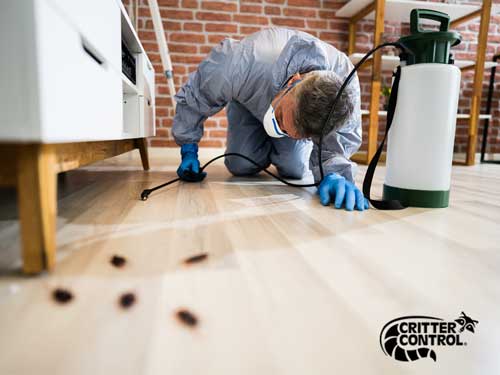Dependable A1 Bed Bug Exterminator Charlotte - Eliminate Bed Bugs Quick
Wiki Article
Bed Insect Treatment Failure: Comparing Chemical Vs. Non-Chemical Solutions
In the realm of parasite control, specifically when managing the relentless issue of bed pests, the option in between chemical and non-chemical treatment remedies can be a pivotal one. Both methods use distinct advantages and disadvantages, affecting variables such as efficiency, security considerations, and total price. By analyzing the nuanced information of each technique, a more clear understanding of which course to seek in dealing with a bed insect problem can be achieved.Efficiency of Chemical Therapies
Chemical treatments for bed pest infestations have actually been widely identified for their powerful and fast effectiveness in removing these parasites. When considering the effectiveness of chemical treatments, it is critical to comprehend that they can provide a quick and comprehensive option to a bed bug trouble. Professional pest control men typically depend on pesticides to target bed pests at different phases of their life cycle, including eggs, grownups, and nymphs. These chemicals usually function by interfering with the bed bugs' anxious system, bring about paralysis and ultimate death.Furthermore, chemical therapies have the benefit of using recurring results, implying that they can continue to remove bed insects even after the first application. This residual action is specifically beneficial in combating any kind of prospective re-infestations. Furthermore, the fast action of chemical therapies can bring relief to people encountering extreme bed insect infestations, enabling them to regain control of their space quickly.
Security Problems With Chemical Solutions
One crucial element that needs careful consideration when using chemical options for bed insect treatment is ensuring the safety and security of residents and the atmosphere. While chemical treatments can be efficient in getting rid of bed bugs, they may pose threats otherwise managed correctly. Among the main safety and security worry about chemical remedies is the prospective damage they can cause to human health. Direct exposure to certain chemicals made use of in bed insect therapies can cause respiratory system issues, skin inflammation, or various other adverse responses, especially in individuals with pre-existing problems or sensitivities. Additionally, incorrect application or dose of chemical pesticides can cause hazardous residues remaining in the cured area, posing lasting health dangers to occupants.Moreover, the ecological impact of chemical services is another considerable factor to consider. Some pesticides used in bed insect therapies may be damaging to useful pests, wildlife, and ecological communities if they seep into the soil or water systems. It is important to utilize chemical therapies sensibly, adhering to safety guidelines, and considering much less poisonous options to alleviate these risks and make sure the safe and efficient monitoring of bed bug problems.
Benefits of Non-Chemical Approaches
Thinking about the potential safety and security problems and ecological impact associated with chemical services for bed bug therapy, exploring non-chemical approaches offers an appealing alternative with numerous distinctive advantages. Non-chemical therapies are eco pleasant, as they do not add to air or water contamination, making them a sustainable option for pest control.In addition, non-chemical remedies can be effective in targeting bed pests, including hard-to-reach locations where chemical treatments may not permeate. Approaches such as heat treatment, vacuuming, vapor cleaning, and bed mattress coverings supply extensive eradication without using harmful chemicals. In addition, non-chemical methods can be less turbulent, needing very little prep work and permitting quicker reentry into dealt with areas. On the whole, additional hints going with non-chemical bed bug therapy methods not only focuses on safety and security and environmental defense however also makes certain efficient and extensive insect control.
Limitations of Non-Chemical Treatments

In addition, non-chemical therapies commonly call for numerous applications to achieve effective removal. This can be time-consuming and may not always guarantee complete elimination of all bed bugs and their eggs, especially in covert or hard-to-reach locations.
Moreover, the success of non-chemical therapies greatly relies upon proper application and thoroughness, which can be testing for people without professional experience. Inadequate application of non-chemical approaches might cause insufficient obliteration, bring about persistent problems and the demand for extra treatments.
Consequently, while non-chemical treatments have their advantages, it is necessary to acknowledge these constraints and consider them when figuring out the most effective approach for taking care of bed insect problems.
Cost Comparison: Chemical Vs. Non-Chemical Options
Offered the limitations connected with non-chemical treatments, a vital element to review in the context of bed bug monitoring is the cost comparison in between chemical and non-chemical alternatives. In contrast, non-chemical therapies like warm treatment or vapor can be more costly, with prices ranging from $1,000 to $6,000 you can look here for an entire home. While the first price of chemical treatments may seem reduced, numerous therapies may be needed to totally remove the infestation, potentially raising the overall expense.Conclusion

Taking into consideration the prospective safety and my company security problems and environmental impact associated with chemical remedies for bed pest therapy, exploring non-chemical methods offers a promising option with numerous distinctive advantages.Offered the limitations connected with non-chemical therapies, a necessary facet to evaluate in the context of bed insect monitoring is the cost contrast between chemical and non-chemical choices. In contrast, non-chemical treatments like warm treatment or steam can be a lot more pricey, with costs ranging from $1,000 to $6,000 for a whole home. While the first expense of chemical therapies may appear lower, several therapies might be called for to fully get rid of the infestation, possibly boosting the general price.In conclusion, when comparing chemical and non-chemical bed pest treatment options, it is crucial to consider efficiency, safety and security, benefits, restrictions, and price.
Report this wiki page